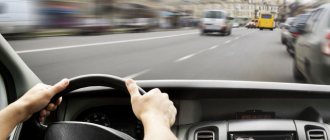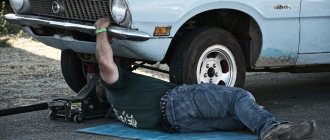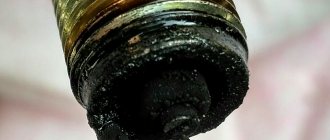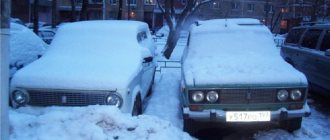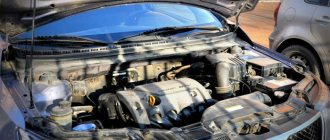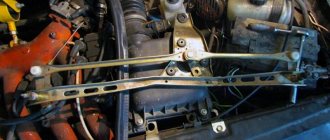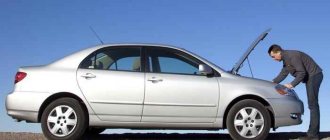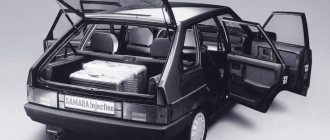A car that stalls while driving can create a dangerous situation no matter where it occurs.
If you are driving, even at low speed, and your car suddenly stalls, it is quite possible that someone will not be able to brake in time and will crash into the rear bumper of your car. And if the car stalls on a busy highway, then there is a high probability of getting into a very serious accident.
If your car stalls while driving and won't start, the possible reasons can be very varied. In this article we will look at the 6 most common reasons for this behavior of a car on the road, and also consider methods for solving this problem.
First reason – Generator malfunction
Alternator failure is one of the most common reasons why a car stalls while driving. Most drivers believe that if the generator fails, the car will not start. In practice, everything is a little different, if the battery is charged, your car can be started, and it will work even with a faulty generator.
The thing is that at this moment the car is powered not by the generator, but by the battery. But this will ultimately lead to the car stalling at the most inopportune moment and no longer starting due to the low battery charge.
Checking the battery charge level is very simple using a voltmeter. The check should be carried out after the car has been parked for several hours. All manipulations are carried out with the engine turned off and the headlights off. Open the hood and connect a voltmeter to the battery terminals. To do this, the positive terminal of the voltmeter must be connected to the positive terminal of the battery, the negative terminal to the negative terminal.
Remember that fully charged car batteries should show a charge of at least 12.66 volts. At voltage values below 12 volts, the car most likely will not start. And when measuring the voltage with the car running, normal parameters are considered to be somewhere around 13.4 - 14.4 volts. Values lower or higher indicate a malfunction. Look for a problem in the generator or relay regulator.
We check the serviceability of the internal parts of the engine and timing belt
As many people know, the timing belt consists of a crankshaft, pistons and camshafts with valves. This device is driven by a chain or belt drive.
All the shafts have a certain position when the engine is running, however, it may happen that excessive wear of the chain, or perhaps the belt and even the gear with sprockets, can lead to the fact that one of the shafts begins to either be late or ahead of its intended purpose.
Professionals call this incorrect adjustment of the ignition system timing angles.
It happens that the belt is too tight and starts to jump on the gear when driving, which can also cause your car to stall. And you won’t be able to start the engine until the problem is fixed.
You can independently determine the condition of the timing belt, as well as whether the shafts are installed correctly. To do this, you need to pay attention to the labels. To do this, you need to rotate the crankshaft manually and align the marks on the front cover of the “engine” and the pulley. Exactly the same marks located on the camshafts must match.
The coincidence of all marks indicates that the timing angle is set correctly; if the marks do not match, then this is precisely the problem. There is no way to do the damage yourself; it will require special skills and certain tools. You will have to contact a car service center for help.
If you neglect to replace the timing belt in a timely manner, sooner or later a break will occur and the engine may seize. This is the most serious consequence for the power plant. In this case, you cannot do without a major overhaul. When jamming occurs, a “meeting” of pistons and valves occurs, during which the crankshaft is unable to rotate. A wedge can be defined as follows: turn the crankshaft by hand; if there is no rotation, then the “engine” is jammed.
Sometimes after a hard day at work you want to play your favorite games, the site contains many games about drifting, you can play them for free, and there are also many games of other genres.
The reasons when a car stalls while driving sometimes indicate damage to internal engine parts, for example:
- The pump in the cooling system is stuck.
- The connecting rod from the piston group was bent.
- The belt tensioner roller in the timing system is jammed.
- The connecting rod/main bearing of the crankshaft rotates.
Such breakdowns are possible due to a malfunction of the generator. The battery is quite capable of having a bad effect due to a malfunction, or if the terminal has come off.
Second reason - Fuel pump
Unfortunately, there is no warning that your fuel pump is about to fail. The first time you notice any problems is only after the car stalls. And with this malfunction, the car cannot be started again.
The serviceability of the fuel pump can be determined by a characteristic light buzzing sound after turning the key in the ignition to start the engine. If you don't hear any noise from the fuel tank when you try to start your car, it's likely that your fuel pump has failed. Since the car will not move with this problem, all you can do is tow the car to a car service center.
The engine stalls when switching to neutral
The reasons that the engine stalls at idle may be identical to those when the car is moving. But there are also problems inherent only in idling engine operation.
A common problem is a malfunction of the idle speed sensor, which is directly related to the operation of the power unit in this mode. You can check the status of the sensor yourself as follows. If the engine does not start at the moment of starting, you need to pump the gas pedal several times. When the unit has started, you should take your foot off the pedal and check the engine speed. If they are unstable and “float” chaotically, the likelihood that the problem lies in the sensor is very high. This type of malfunction can be solved by washing the sensor with regular WD-40 or installing a new one.
The second reason is a clogged throttle valve, which simply needs to be washed.
Particular attention should be paid to the throttle position sensor. This can also cause the car to stall while driving and then start.
Fixing this breakdown is quite simple; you just need to replace the sensor, which you can do yourself.
The third reason is that too much moisture has entered the fuel.
If gasoline contains too much moisture, then this mixture, entering the combustion chamber, does not burn properly, interfering with the proper operation of the engine. If you recently refueled, and before that the car was working fine, then the problem is most likely in the fuel.
There are two ways to solve this problem:
- The first is to drain the gasoline from the fuel tank. Then fill it with fresh fuel.
- The second is to try to dilute it with normal gasoline and continue driving with bad fuel until the car uses up all its fuel. Which, of course, is not recommended for obvious reasons. Next time, fill up at another gas station.
Additionally
- Brake malfunction. In this case, the design of the vacuum booster is usually faulty. The problem comes to light when braking hard - resulting in a stalled engine (i.e. it slowly stalls on its own). Usually the entire amplifier is replaced or its adjustment is made.
- Exhaust system. The exhaust system may be contaminated, and after such contamination the car simply cannot “spit out” all the accumulated gas and begins to “choke.” It is necessary to clean the muffler; if the problem is not only contamination, but also a breakdown of the catalyst, the exhaust system must be completely replaced.
Is it due to poor fuel quality? Often the problem is precisely the fuel of low quality, or that does not correspond to the brand of car the driver is driving.
Gas stations need to be carefully monitored. Fuel tends to pollute and contribute to the rapid wear of many vital parts for a car.
When using low-quality mixtures, the following occurs:
- Rapid contamination of the fuel filter.
- Malfunctions appear in the operation of the injection nozzles.
- Throttle valves become dirty quickly.
- The fuel pump is not working properly.
The most important indicator of a malfunction is a gradual decrease in engine power, as a result of which the car will stall even when the gas pedal is sharply pressed. Many problems can be identified yourself without spending extra money to pay for the services of a service center, but if the problem is not eliminated during an external inspection and subsequent repair of fuel systems, you will have to conduct computer diagnostics to more fully and deeply identify problems.
If your car has an automatic transmission and the car periodically stalls while driving, then the problem is usually in the power supply.
When the transmission changes gear, the computer receives a notification that some part is faulty and decides to immediately turn off the engine. Problems with this type of car must be resolved as quickly as possible; repairs must be carried out only by specialists. Personal interference will lead to an even bigger problem.
The fourth reason - Electrical wiring
If the car stalls while driving and does not start, and none of the above reasons apply, then bad wires may be to blame. The first thing you need to do is check the idle air control system for corrosion on the wires. If corrosion is present, then it's time to replace the wiring. It is also equally important to ensure that the wires are connected correctly if any repairs have been made.
Recommendations
So, the car stalled while driving, what to do next:
- Using the inertia of movement, push the car off the roadway, no matter whether it is a city road or a highway.
- Turn on the alarm.
- It is mandatory to install an emergency sign at the back of the car: there are plenty of fans of high-speed driving everywhere, there is no need to create an emergency situation.
- Put the car on the handbrake.
Option 2 for further developments:
- Do the repairs yourself.
- Find a way to transport the car to the service.
In order to avoid such unpleasant and unexpected moments when the car stalls while driving, you need to follow simple rules:
- Carry out vehicle diagnostics at a service center as often as possible.
- Carry out preventive maintenance and inspection of the machine yourself.
- Monitor the condition of parts and replace them in a timely manner so that the machine does not break down in unexpected places.
You should always have a tool with you to repair minor damage, as well as a can of gasoline to avoid stopping due to its absence.
A car that stalls while driving can create a dangerous situation no matter where it occurs. If you are in motion, even at low speed, and your car suddenly stalls, then it is quite possible that someone, unable to brake in time, will crash into your rear bumper.
And if the car stalls on a busy highway, then there is a high probability of getting into a very serious accident. If your car stalls while driving and won't start, the possible reasons can be very varied. In this article we will look at the 6 most common reasons for this behavior of a car on the road, as well as methods for solving this problem.
[custom_ads_shortcode2]
Fifth reason – Low fuel pressure
If your car stalls while driving up or down hills, the problem may be low fuel pressure. If this problem occurs, your machine will not operate reliably.
There may not be many possible reasons for this:
- Excessive wear and, as a result, reduced performance of the fuel pump.
- Clogged fuel system, including pump and filters.
- Vacuum in the fuel tank.
Generally, the vehicle can start and drive on smooth roads without difficulty. However, when going uphill, the car is likely to stall due to low pressure in the fuel system.
Sometimes replacing the fuel filter helps to correct the situation. This is one of the simplest solutions. You can also try adding a little injector cleaner to the fuel tank, but this comes with its own risks.
Weather
The reason for the unstable operation of the engine at idle also includes weather conditions. Very often the power unit stalls when trying to warm up the car in cold weather, which makes this process much more difficult.
So, for example, a gas-powered car stalls at idle due to freezing of the gas in the gearbox. This happens if you warm up the engine not on gasoline, but directly on gas. The gas reducer is heated and connected to the cooling system. Since the unit itself is still cold, and the gas entering the reducer tends to cool when the pressure changes, icing and clogging of the gas pipeline elements and reducer parts occurs. It is this factor that does not allow the engine to idle steadily and without stopping.
To prevent freezing and trouble-free warm-up, the engine must be heated with gasoline until the coolant temperature rises. Craftsmen have adapted to warm up the gas reducer with hot water from a kettle before starting the engine. This prevents premature freezing of gas equipment elements before the engine has already warmed up.
Sixth reason – Problems with the ignition distributor cap
The distributor cap plays an important role in the performance of your engine. The cover is necessary to protect the distributor and its internal rotor. The distributor cap supplies voltage to the spark plugs. If there is something wrong with the cover, the engine may stall or stall. Problems can also be identified by the following signs:
- Presence of holes in the lid;
- Poor condition of the body, namely the presence of cracks;
- Wear or corrosion on contacts;
- Condensation in the housing itself.
If the reason is contacts or cracks, then sometimes it is enough to simply clean the contacts and treat the cover with sealant. Of course, this will not completely solve the problem, but as a temporary measure it is quite suitable. Since this problem will return again and, as a rule, at the most inopportune moment.
If the car is fuel injected...
The engine stalled, what to do if the car is fuel injected. For a car with a fuel injection system, after checking the spark plugs, you should check the fuses for integrity; you need to carry them with you, at least one at a time for different voltages. In such cars, electronics are responsible for a lot of things, and they are often to blame for problems. Then inspect all wires, terminals, contacts and the electronic control unit. It may need to be disassembled and wiped dry. Don't forget to disconnect the terminals from the battery before doing this. The terminals themselves need to be cleaned. If one injector fails, the engine continues to operate, but several injectors cannot fail at the same time.
Other possible reasons why a car may stall while driving
Remember that a car consists of many interconnected mechanisms and components, and a car can stall while driving not only due to problems in the engine, but also due to other vehicle systems.
Here is a list of equally common faults that can cause the engine to stop:
- Engine overheating;
- The coolant temperature sensor or crankshaft position sensor is faulty.
- The fuse has blown.
- Oil or antifreeze has leaked.
- Problems with the throttle valve.
- Clogged spark plugs.
- Wear or damage to crankshaft or timing gear elements.
- The fuel or air filter is clogged.
And even this is not the entire list of problems. If your car stalls while driving and won't start, a possible reason could be that you simply ran out of gas. Yes, you can get into such a situation if you don’t refuel on time.
This is only a small part of the problems that a driver may encounter on the road. But we hope that they will be enough to solve your problem. In any case, if you are a novice driver and have little understanding of how cars work, then the best option is to call someone who knows better about this topic than you. We hope that this article was useful to you. We wish you success and good luck on the roads!
New articles
- Why does a diesel engine stall when cold and smoke white smoke? - Let's look into the issue
- Causes of deposits on spark plugs: white, black, red
The engine began to lose traction and stalled
There are usually only two reasons for this malfunction, the first is rain and puddles. Usually this is the case, in dry weather the engine runs well, but in the rain it starts to stall and flood the spark plugs. Most likely there is no engine protection at the bottom, water gets on the spark plugs, ignition wires, and floods the ignition coil. At this moment, the spark may go to ground, which causes poor ignition of the working mixture in the cylinders, unburned gasoline floods the spark plugs. Wipe the wires and everything listed above dry, drive slowly, especially through puddles, so that water does not flood the electrical equipment again.
This is interesting: How to remove the power window control unit
Either drops of gasoline fly into the carburetor or injector air manifold through the breather hose, also causing spark plug failures, remove the breather from the filter and the path blows onto the street, hang up where the breather hose is attached, plug it with a plug or rag, the engine is fine, you can go.
Secondly, the carburetor begins to overflow gasoline; often this problem is caused by either a worn carburetor needle, or a speck has gotten under the needle, which leads to an overflow of gasoline. The injector, here is more complicated, cannot be repaired on the road, diagnostics are needed, which should reveal the reason for the strong enrichment of the working mixture; more often than not, the temperature sensor is to blame for this problem. It shows the computer that the engine is colder than it actually is, the computer gives a richer mixture, which leads to flooding of the spark plugs.
Conclusion
If you suddenly stop on the highway, there is no need to panic. You can most often find the cause of the stop and eliminate it yourself. This article will help you do this without any problems.
Monitor and maintain your vehicle promptly. Don't let your car fall into disrepair and then it won't let you down either. Visit only trusted car services.
Subscribe to our YandexZen
3 368

